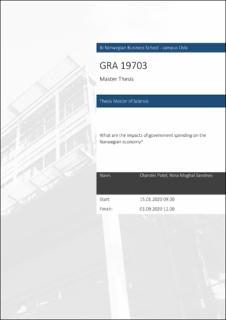| dc.description.abstract | To analyse the effects of government spending, we use a structural vector
autoregressive (SVAR) model. The recursive approach relies on the Cholesky
ordering and is applied to identify a government spending shock. We apply
quarterly data from Norway, with sample period 1991:1-2019:3. In the baseline
model we find a short-lived, positive and significant effect on GDP, inflation and
interest rate. The resulting multiplier is below one for all horizons, which could be
consistent with the New Keynesian model. Extending the model, a shock to the
two components of government spending, public consumption and public
investment, is applied. Our main findings suggest that public investment has the
largest impact, leading to a persistent and positive effect on GDP. However, the
effect on GDP may also be influenced by a fall in the interest rate. Private
consumption is included as another extension. The effect on private consumption
is not positive, although it does not have a clear fall either, being insignificant for
the whole period. Because consumption does not rise, as well as the interest rate
reacts negatively, our results are leaning more towards the New Keynesian model. | en_US |
